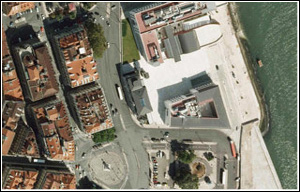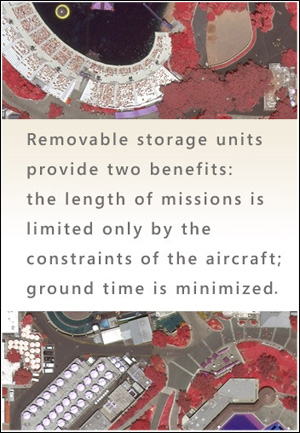    |
|
|
| |
|
| |
|
|
| |
The UltraCamXp has an even larger image format than
its predecessor at 196 megapixels (17,310 across track
x 11,310 along track), and a smaller pixel size at 6
µm. By offering the largest image format available,
the UltraCamXp reduces the number of flight lines, saves
time, and lowers cost, without sacrificing radiometric
performance.
 |
UXCp
image of Portugal coastline courtesy of
Aerodata
International Surveys |
Increased onboard storage capacity allows for longer
flights to take full advantage of favorable flying conditions,
and the collection rate of 2.5 Gbits per second allows
for collecting more data in less time.
The UCXp is capable of collecting stereo imagery at
a remarkable 1 inch GSD at a flight speed of 110 knots.
Post-processing of the data can be started on board,
and finished on the ground with a group of PCs for even
faster turnaround.
As major projects are completed in an impressively
short period of time, in relation to the number of pixels
collected, this guarantees a highly efficient project
execution and completion certainty.
|
|
| |

 |
| UXCp
image of Portugal coastline courtesy of Aerodata
International Surveys |
F E A T U R E S

 Top
Top
The UltraCamXp makes use of the same data flow concept
introduced with the UltraCamX that allows unlimited
image collection in the air. Now, however, the low-cost,
exchangeable DXp data storage devices hold even more
data—approximately 4.2 TB, the equivalent of around
6,600 UCXp images.
UCXp Features
- Largest format available (196 megapixels; 17,310
across track, 11,310 along track) means fewer flight
lines, less time, and lower costs
- Short frame interval allows multi-ray photogrammetry
even for large-scale mapping at low altitude and high
aircraft speed; forward overlaps of 60% are achieved
at a 1 inch pixel size at 110 knots
- Removable storage units provide two benefits: the
length of missions is limited only by the constraints
of the aircraft; ground time is minimized
- Maximum use of legacy environments; supports ALL
standard gyro-stabilized camera mounts (PAV-30, Z/I-TAS,
GSM3000) and most common GPS/IMU systems
- Pixel size on the ground (GSD) at flying height
of 500 m is 2.9 cm (1.8 cm at 300 m flying height)
- 1:3 pan-to-color ratio delivers stunning color and
color-infrared (CIR) image quality and negligible
image vignetting
|
|
| |

C O N F I G U R A T I O N
S
 Top
Top
Sensor Unit (SXp)
- Simultaneously collects Pan, RGB and NIR
- Panchromatic image size 17,310 x 11,310 pixels;
color and NIR image size 5,770 x 3,770 pixels
- Weight of SXp ~ 55kg
- Pixel size on the ground (GSD) at flying height
of 500 m is 2.9 cm, and at 300 m is 1.8 cm
Computing Unit (CXp)
- Processes raw images on board in real time, to compute
quick views and histograms
- 14 CPUs for computation of interim data products
for in-the-air image quality assessment
Data Units (DXp)
- In-flight storage capacity limited only by number
of DXps on board, given space and weight constraints
of aircraft
- Approximately 6,600 uncompressed images per DXp
unit (~4.2 TB) can be stored
- Stores mirror images of the data on two DXp units
Operational Specifications
- Post-processing can begin in the air and be completed
on the ground with a laptop or group of PC’s
- 11 hours of collection time per single DXp unit
at 70% and 20% overlap at 20 cm GSD, 140 knots
- Image geometric accuracy is approximately +/- 2
µm
Options
- Mobile Server, high capacity storage on the ground
|
|
|
|

Copyright© Imagemaps Pte Ltd. 2010. All rights reserved. |
|



